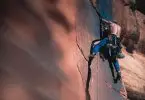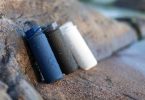HyVent vs Gore Tex, it’s certainly a debate for the ages! Gone are the days when waterproof outdoor gear selection was a walk in the park. Those are the days when the indispensable Gore Tex membrane was the only option for a breathable fabric.
Nowadays, there are many other such materials (utilizing similar technology as the Gore Tex to yield) durable, waterproof, windproof and breathable masterpieces such as HyVent, eVent, MemBrain, Patagonia etc. Following this, many textile brands exist too which has resulted in an overwhelming variety of outdoor wears.
For you to make a better choice, it’s of great importance to differentiate these magical membranes by understanding their properties and technical details. Are you interested in knowing what exactly keep off sweat and water from your Gore Tex and North Face jacket?
See also: Gore Tex Ponchos: A Handy Buyer’s Guide for Choosing a Rainwear That’s Right for You
Well, you’re in the right place as in this write-up, we’ll cover both the HyVent and Gore Tex membrane, showcasing each from the other to give you an understanding that will result in a more informed choice. Let’s get started with…
Their manufacturing and working mechanism
Gore Tex (a microporous membrane)
Gore Tex is Wilbert’s son, Bob, discovery. An invention dated back to 1969. It was a happy incident, partly out frustration when Gore accidentally overstretched the PTFE by over 800% resulting in a microporous membrane (70% air). The discovery was then introduced to the public and afterward, Bob applied for 3 US patents which he acquired making him its legal inventor.
The membrane is generally described as a laminate, a membrane but mostly as a promise. It’s tested and proven to deliver on its promise to keep you dry throughout the day.
Gore-Tex is made by modifying PTFE into an expanded form thermo-mechanically. In PTFE, commonly known as perfluorocarbon resins, all carbon atoms in the polymer chain are completely bonded to fluorine atoms. The resulting bond is so strong that neither UV light nor oxygen is energetic enough to break it.
This makes it possible for PTFE to be overstretched by 800% under controlled conditions resulting in a microporous membrane. The membrane is impregnated with oil and insect repellants substances to protect it from contamination by body oils and damage by insects.
The microporous masterpiece is a thin film containing numerous pores (about 14 million tiny pores per millimeter squared). These pores are 20,000 times smaller than water droplets which limit water in liquid states from passing through and 700 times larger than water vapor particles enabling sweat vapor to pass through. The pores link together in complex patterns which serve as a filter.
To keep the membrane waterproof, the pores rely on surface tensional forces. Water having high surface tension, normally beads off certain surfaces. However, if the material has got contaminants such as oils, leaking is bound to happen. Why?
Oils have a low surface tension which causes them to creep into the micropores rather than beading. Once inside, the contaminants affect the natural interaction of water with the pores, potentially causing leaking.
This microporous membrane being fragile, it’s normally bonded with outer fabric materials such as nylon, polyester etc. and inner materials such as fleece forming a laminate. Gore-Tex laminates come in various forms based on their use.
Must read: Gore Tex Spray: Everything You Need to Know About This Waterproofing Spray
Such constructions include a 3-layer construction (in which the membrane is sandwiched between two face fabrics) and 2-layer fabric construction (in which the membrane is sandwiched between a face fabric on one side and a liner on the inner side allowing for insulation). These coatings/sandwich materials should have similar properties as the membrane for a breathable laminate.
Laminate constructions are produced by knitting or weaving textile fibers and the resulting stitches can cause water/liquid leakage. To prevent this, Gore-Tex makes use of Gore seam tape for sealing purposes in limited amounts as too much taping can render the fabric less breathable.
It’s garments work best in cool to cold/freezing temperatures making it suitable for campers, skiers, hikers, and mountaineers.
HyVent (a continuous hydrophilic membrane)
This membrane is a North Face’s waterproof-breathable technology. It’s engineered to provide excellent breathability, waterproofing, and durability for multi-purpose use. The membrane has been tested both in the lab and field to ensure premium quality and maximum performance.
It’s made of PEO (polyethylene oxide) and PU (polyurethane) mixture consisting of a tri-component, multi-layer formula which offers excellent longevity, water permeability and waterproofing properties. The formulation is a solid hydrophilic film without pores. In addition, the resulting membrane is impermeable to air making it windproof.
Being fragile, the membrane is sandwiched with other fabrics in 2, 2.5 and 3 layer construction. The 2 layer protects the PU film using a hanging liner, whereas the 2.5 construction incorporates a ‘dry touch’ texture that lifts the coating from the skin giving the fabric better longevity and comfort. HyVent 3-layer construction is similar to that of Gore Tex only that the latter utilizes ePTFE synthetics rather than a PU film.
Moisture transportation is by molecular wicking process. This can be thought of as capillarity or water flowing across step stones. The liquid molecules are adsorbed to the hydrophilic material surface first and then onto the next molecule in the series. The wicking process continues through the entire thickness of the material. See our tips on how to choose the best Gore-Tex ponchos to give you more choices and options.
This creative technology perform best in snow, mountainous conditions and in rain making it ideal for mountain trekking in harsh winter conditions, skiing, snowshoeing, snowmobiling etc.
Their properties and technical details
These fabrics possess 2 crucial properties a discussed below.
Waterproofness
Terming a fabric as waterproof means it can withstand water pressures it’s likely to encounter as you pursue your outdoors. According to British standard, the term waterproof is taken to imply that the liquid penetration resistance of a fabric is equal to its hydraulic-bursting strength.
The standard also states that, for a fabric to be labeled as waterproof, it should withstand pressures equal to or greater than 10 kilopascals (1000mm hydrostatic head). I.e. The height of water that the fabric can withstand before leaking.
Waterproofness is tested using various methods: hydrostatic head testing, repellency test, and rain room testing. Hydrostatic testing is the most commonly used method. It’s done using a hydrostatic head tester based on British standards. The gadget measures the amount of water a given fabric can tolerate and the results are in units of length or pressure.
On undergoing such tests, Gore Tex was found to have a waterproofness of >28, 000mm while HyVent had above 15,000mm. Based on statistics, it’s clear that Gore Tex is more waterproof than HyVent.
Breathability
Sweating is natural, it’s an air conditioning for the entire body. As mammals, the body try to regulate its temperatures maintaining them at constants levels. Therefore, when we’re active, we sweat to get rid of excess heat produced by the muscles.
If the resulting water vapor (sweat) is allowed to accumulate, you risk overheating whilst active and being chill while at rest. Note, being wet in icy conditions can cause hypothermia and thus sweat accumulation should be avoided at all cost. This calls for breathable garments.
Luckily, both Gore Tex and HyVent are breathable. The former get rid of sweat via a diffusion process through pores that are 700 times larger than the resulting vapor, whereas HyVent makes use of a molecular wicking (explained above) to boost the garment’s breathability.
There’re numerous scientific tests for measuring breathability of a fabric such as inverted cup method, RET (Hohenstein Method) etc. The most common test measures the moisture vapor transmission rate of a material (MVTR). I.e. the amount of vapor (in grams) that can penetrate a meter squared area of a given fabric in 24 hours. From the test, the fabric with a high MVTR can be concluded to be more breathable.
Unfortunately, such results can be inconclusive as breathability strongly depends on temperature and humidity gradient between the body and the surrounding. That’s to say, hiking in Tully Northern Queensland will significantly slow the breathability of your gear, whereas scrambling up Mt Ossa in say, September, your shell will breathe way better.
Nevertheless, the two fabrics when tested for breathability, the results were found to be 17,000 GM/M²/24HR for Gore Tex and 12-15,000 GM/M²/24HR for HyVent membrane.
Other than the two properties, these fabrics are also light in weight, durable, packable and windproof which earn them usefulness in textile industries, military, aerospace among other such fields.
Advantages of HyVent over Gore Tex fabric
Much as the two perform based on a similar principle with slight modifications, HyVent has some benefits over Gore Tex as outlined below.
- Wears made of the fabric are way cheaper (approximately ½ the cost) when compared to those from Gore Tex.
- Hydrophilic material are easier to stretch as compared to ePTFE making HyVent the cheaper option while manufacturing stretchable materials.
- HyVent is easier to patch with adhesive patches, unlike the ePTFE material.
- HyVent garments are lighter and more packable which help save on backpacking space.
Disadvantages of HyVent fabric as compared to Gore Tex
As promising as it is, the membrane has some demerits when compared to its competitor. These are outlined as follows:
- It’s less durable and,
- It’s less breathable.
So, where are we on the two technologies?
In the business world, there exist stiff completion. And, with that on price becoming too expensive, brands are turning their focus to producing quality products and ensuring maximum customer satisfaction. Well, you can’t boost the quality of your product without research, can you?
The North Face and Gore Tex traders consistently carry out lab and field tests to determine on areas of their technology in need of improvement. The results are combined with the ever advancing technology to yield better masterpieces that are way personalized to suit your needs, location etc. Here are examples…
HyVent
The North Face fabric features several technologies as outlined below.
- HyVent alpha – The membrane was engineered for use in Summit Series production. It features a unique laminate construction for improved durability and waterproofing. Its hydrophobic and microporous lamination technology ensures that the fabric remains effective even in harsh conditions. It’s ideal for snow sports and mountain adventures.
- HyVent 2L – It’s a 2-layer construction for optimal breathability making it ideal for high adrenaline adventures and expeditions. The fabric consists of a woven, durable and abrasion resistant outer layer and a PU inner layer with micropores for vapor permeability. It’s effective in snowy and rainy conditions for comfortable warmth and dryness. Best for tough outdoor pursuits such as skiing and rock climbing.
- HyVent 3L – It’s a 3-layer construction for maximum moisture management, durability, and breathability. The technic is similar to that utilized in 2L only that in 3L, the PU film is located in the middle layer. The fabric is best suited for sports and mountain adventures.
- HyVent DT – The construction principle is that of a 3L with a reduction in the overall thickness to save on weight and pack space. In this, a PU coating is applied with a DT print that serves as a ‘dry touch’ half coating. This boost the fabric durability and comfort by lifting the PU film off the skin while eliminating the need for an inner lining.
- HyVent DT EC – This’s a more environmentally friendly material engineered from castor oils rather than petroleum products. The fabric reduces synthetic use by 50% whilst maintaining superior breathability, waterproofing, moisture management and durability. It’s ideal for any outdoor pursuit from hiking to rock climbing.
Gore Tex
As a go-to fabric in the geotextile industry, Gore Tex can be termed as a household name. The material has gained a good reputation and much awareness following its consistent reliable performance and dynamite marketing. Here are some of its recent technologies.
- Gore Tex PacLite – The fabric is ideal for activities that require light packing. It’s a 2.5-layer construction suitable for urban wet-weather travel rather than strenuous outdoors.
- Gore Tex Active – As the name suggest, the fabric is ideal for high adrenaline outdoor pursuits. It’s a 3-layer construction for maximum protection.
- Gore Tex Pro – The fabric is specifically engineered for severe environments. It’s crafted from multiple ePTFE layers to boost its durability and reliability in harsh conditions. The material lack oleophobic lining making it 25% more breathable than the earlier PRO versions.
- 3-layer construction with Gore C-KNIT – The membrane makes use of backer technology that provides durable, water and windproof protection while optimizing on comfort. The bi-component membrane is bonded to a thin yet dense and lightweight knit to form a laminate. It weighs less by 10% and breathes more by 15% as compared to previous 3-layer constructions.
Summing up
With the breathtaking variety of outdoor wears, it’s a necessity to understand the technical details behind the brands’ labels and claims so as to make a more informed decision. As seen above, we have tried to cover HyVent and Gore Tex membrane, showcasing each from the other in terms of their properties, working mechanisms, and advanced technology. To check out our review of the best Gore-Tex hiking shoes, see our earlier article to find out more.
It’s important to understand that some of these properties depend on many factors and thus don’t just rely on the ratings provided by the manufacturers. Rather, use them as guides to select just the right outfit. In addition, remember to properly clean your garments as dirt and oils can reduce their wind and waterproof durability.
Featured Image Source: https://unsplash.com/photos/WCvi4vCs7qg








